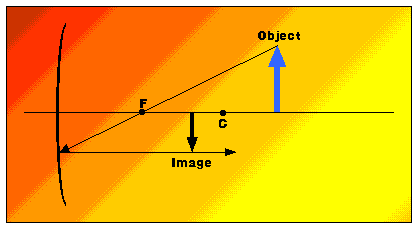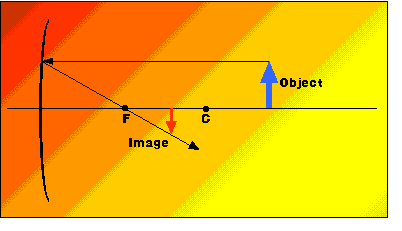
In the figure below, the ray that passes through the focus of a concave mirror and is reflected parallel to the axis of the mirror is shown. The height of the object placed in front of the mirror is labeled Ho, the height of the image is labeled Hi. The distance between the object and the focus of the mirror is labeled Do, and the focal length is labeled f. The two shaded right triangles are similar. (Why?)

Since corresponding sides of similar triangles are proportional, we can write:
This is an interesting and useful equation. For example, suppose you place an object 5.0 cm. tall 20 cm. from the focus of a concave mirror with a focal length of 10 cm. Using the notation above, therefore, Ho = 5.0 cm, Do = 20 cm, and f = 10 cm. Then, using the equation above, we can calculate the image height, Hi:
which means that the height of the image should be 2.5 cm. Is it? Well, yes - 2.5 cm will be an excellent approximation to the actual height of the image, but it is NOT EXACT. Why not? Look again at the figure above (the one with the two triangles). Notice that the distance in the right-hand triangle labeled "f" is not exactly equal to the focal length of the mirror. (If you had already noticed this, give yourself a pat on the back, you're a scientist!) This triangle does not extend all the way to the vertex of the mirror due to the curvature of the mirror, so that the labeled distance is actually slightly less than the focal length. This means that "Equation 1" is an approximation. (This is the price we pay for simplicity...) The approximation will be very good, as long as the object is not very big compared to the size of the mirror.
before.
Now, this equation is not, as it stands, useful. But there's hope... Equation 1 can be rearranged so that it, too, has the ratio Hi/Ho on the left side:
Also, the equation derived in the diagram above can be rearranged to place Hi/Ho on one side:
Setting the two expressions on the right equal to each other gives:
or, after "cross-multiplying"::
Another very useful result.
Remember from the previous example, where Do (distance from the object to the focus) = 20 cm and f (focal length) = 10 cm. Using this data, the image distance, Di, can be calculated:
Equation 1 and 2 also work for situations where the object is placed between the focus and the mirror. In this case, the object distances are negative. Suppose the object 5.0 cm. tall is placed halfway between the focus and the mirror whose focal length is 10 cm. In this case, Ho = 5.0 cm, f = 10.0 cm, and Do = -5.0 cm.
Using Equation 1:
The image is 10 cm tall, and the negative sign means that the image is right-side-up. Now using Equation 2:
So the image is located 20 cm from the focus, on the opposite side of the focus as the object. Since the focal length of the mirror is 10 cm, this places the image 10 cm behind the mirror. Thus, Equations 1 and 2 predict a right-side-up image 10 cm tall located 10 cm behind the mirror. You should confirm that a ray diagram makes the same prediction, and, even better, try it with a real mirror!
Equation 2 has a lot to say about the relationship between object distance and image distance, too. For a particular mirror, the focal length, f, is fixed. This means that if Do (object distance) is large, then Di (image distance) is small, and vice versa. Also, Do and Di must always have the same sign - either both positive or both negative. Physically, this means that the object is placed farther from the mirror than the focus, then the image is located beyond the focus also (both positive), and if the object is between the focus and the mirror, then the image is located on this side of the focus, too (both negative). This is precisely what we found from the ray diagrams.